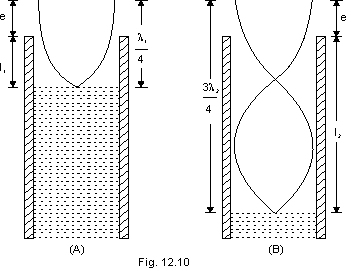Experimental Physics - 7
Principle:
If a vibrating tuning fork is held over the open end of the resonance tube T filled with water, as shown in fig12.9(a) then resonance is obtained at some position as the level of water is lowered. If E is the end correction of the tube and l1 is the length from the water level to the top of the take, then

Where v is the velocity of sound in air and f is the frequency of tuning fork or air column.
Now, the water level is reduced to alower value, as shown in fig 12. 10(b). until a resonance is again obtained. If l2 is new length of air column and  2 is the wavelength of sound wave, then
2 is the wavelength of sound wave, then
Substracting equation (12.8) from (12.9), we get
Eliminating  from equation (12.8) and (12.9), we get
from equation (12.8) and (12.9), we get
l2 + e = 3(l1 + e)
or e = 
METHOD:
(i) The resonance tube is leveled Vertically with the help of a plumb line and the leveling screws. the reservoir and some part of the tube is filled with water.
(ii) The pinchcock is released and the level of water is adjusted close to the top end of the tube. then, the pinchcock is closed and the position of the reservoir is lowered.
(iii) The tuning fork is struck against a rubber pad and the vibrating tuning fork is placed just above the open end of the resonance tube so that the prongs of the fork vibrate in avertical plane. Now, the pinch-cock is slowely opened and the watr level in the tube is allowed to fall gradually. At the position when the air column is in resonance with turning fork, the position of the water level is noted.
(iv) Now, the pinch-cock is closed and level of reservoir is raised. The step (iii) is repeater by opening the pinch-cock. thus two readings of the first resonance position are recorded: one by lowering the water level in the tube and the other by raising the water level in the tube. The length of air column at this position is given by l1
(v) Now, the level of the water in the tube is decreased such that air column in the tube becomes three times l1. Once again, two readings of water are taken in accordance with step (iii) and (iv) at which it comes in resonance with the tuning fork. This reading is recorded as second resonance condition of the tube with tuning fork. This Reading is recorded as second resonance condition of the tube with turning fork. This reading is recorded assecond resonance condition of the tube with tuning fork. This Reading is recorded as second resonance condition of the tube with tuning fork. The length of the air column at this condition is given by l2.
Illustration: The velocity of sound in air is measured using a resonance tube method. The observation madedring the Experiment are as follows:
Frequancy of first tuning fork f1 = 480 Hz.
Frequancy of second tuning fork f1 = 512 Hz.
Position of upper end of the Tube, L1 = 0.2 cm.
Room temperature T = 250c
| Frequency of fork | Resonance | Position of water level of resource l2 (cm) Water falling Water rising mean l2 | Mean length of air column L2 - L1 (cm) |
| 480 | First Second | 17.0 17.2 52.4 52.6 | |
| 512 | First Second | 16.4 16.2 49.9 50.1 |
Calculate:
(i) The velocity of sound at room temperature.
(ii) The End correction for the tube.
Solution:- The observation table is completed as shown below:
| Frequency of fork (Hz) | Resonance | Position of water level of resource l2 (cm) Water falling Water rising mean l2 | Mean length of air column L2 - L1 (cm) |
| 480 | First Second | 17.0 17.2 17.1 52.4 52.6 52.5 | l1 = 16.9 l2 = 52.3 |
| 512 | First Second | 16.4 16.2 16.3 49.9 50.1 50.0 | l1 = 16.1 l2 = 49.8 |
(i) Velocity of sound:
f1 = 480Hz ; l1 = 16.9 m ; l2 = 52.3 cm = 0.523 m
 V1 = 2f1(l2 - l1)
V1 = 2f1(l2 - l1)= 2(480)(0.523 - 0.169) = 340 m/s
For f2 = 512 Hz ; l1 = 16.1cm = 0.161 = 0.161m ; l2 = 49.8 = 0.498m
 V2 = 2f2(l2 - l1)
V2 = 2f2(l2 - l1)or V2 = 2(512)(0.498 - 0.161) = 345 m/s
The average velocity of sound is

(ii) End - correction of the tube
For f1 = 480 Hz

For F2 = 512 Hz

The average end correction is
